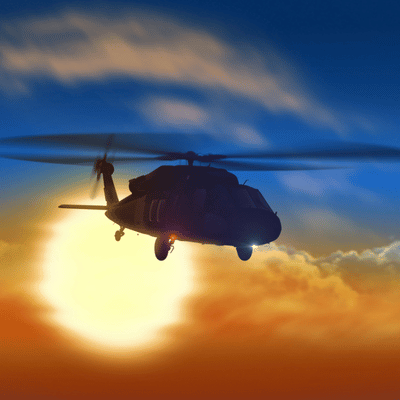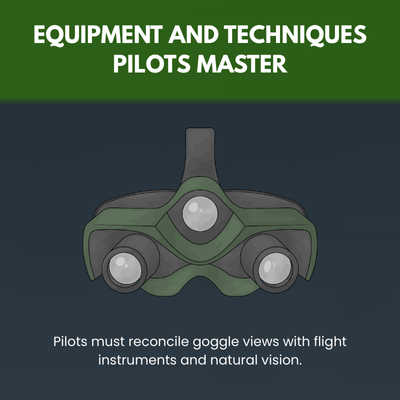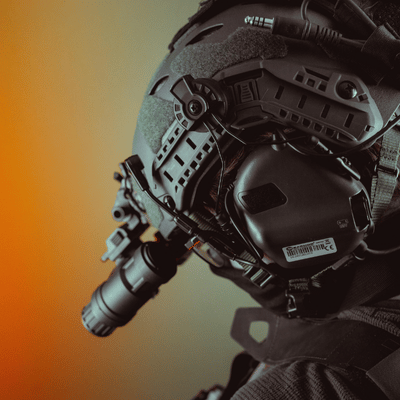Flying helicopters at night presents unique challenges that demand specialized skills and equipment for any night vision goggle pilot in different flight environments. Night vision goggles have become essential tools for pilots operating in darkness, and the goggle system must work well with flight instruments.
But wearing these devices requires more than just strapping them on, with proficiency testing, emergency procedures, and real flight experience forming a core part of aviation night vision goggle operations. Proper training ensures pilots can use this technology safely and effectively across varied flight environments.
Why NVG Training Matters for Safety

Night flight operations limit a pilot’s visual references. This increases risks from hidden obstacles and terrain. Night vision equipment amplifies low-light images to help pilots maintain visual contact with the ground. This technology transforms dark scenes into visible green or gray images.
However, night vision systems also create new challenges. The typical aviation goggle provides only a 40-degree field of view. This narrow cone compares poorly to normal human peripheral vision. Depth perception becomes reduced, and everything appears in single color tones.
Bright lights can cause blooming in the goggles. The devices cannot see through weather like clouds or fog. Pilots without proper training may develop false confidence or become disoriented. History shows that poor training or overuse of night vision can lead to accidents.
The FAA requires pilots to undergo specific training before flying as pilot-in-command with these devices. Regulations treat night vision goggle operations as an additional pilot qualification. Rules exist because operating with this equipment demands specialized knowledge and skills.
What Night Vision Goggle Flight Training Courses Include
Most programs structure their curriculum around ground training and flight training components. A typical night vision training course includes several hours of classroom instruction followed by dual flights wearing the equipment.
Ground Training Components

The academic portion covers essential knowledge areas. Students learn how night vision systems work, including image intensifier tube technology that amplifies ambient light. They study different generations of goggles and components of each goggle system.
Generation 3 devices represent current state-of-the-art for civil aviation. These use advanced photocathodes and micro-channel plates for high light amplification. Pilots learn about optics, image intensifiers, power supplies, and helmet mounts.
Training covers FAA rules and operating procedures for night vision goggle operations. This includes reviewing regulations like 14 CFR 91.205(h) for aircraft lighting requirements. Students study standard operating procedures and consistent techniques for flying with goggles.
The curriculum addresses human vision and how eyes adapt to darkness. Pilots learn about protecting night vision before flights and how rod cells work in low light. Topics include fatigue effects, stress impacts, and circadian rhythm influences on night flying.
Terrain recognition becomes different when viewing through tinted goggles. Pilots learn which visual cues prove reliable and which can mislead. Training emphasizes scanning techniques to compensate for restricted vision. Students must employ disciplined head and eye movements to cover their entire visual area.
Flight Training Elements
After completing ground school, pilots move to night flights with qualified instructors. The flight curriculum covers several key areas.
Pre-flight preparation teaches proper goggle inspection and aircraft setup for night vision goggle pilot operations. Students learn to check objective focus, diopter settings, and battery levels. Aircraft must have compatible cockpit lighting to avoid goggle glare.
Basic flight maneuvers include straight-and-level flight, climbs, descents, and turns while wearing goggles. Hovering receives special attention since altered depth perception affects this critical skill. FAA currency rules require pilots to log hovering tasks to remain current.
Navigation training teaches pilots to read landscapes with goggles. This involves identifying rivers, roads, hills, and other features at night. Some programs use Virtual Terrain Board training systems for immersive classroom practice before real flights.
Advanced training procedures cover emergency situations while wearing goggles. Students practice autorotations, hydraulic failures, and other system failures under night vision conditions. These challenging scenarios build confidence for handling real emergencies.
Crew resource management training addresses coordination between pilots and crew members. Communication becomes critical when one pilot focuses on instruments while another scans visually. Many courses incorporate flight mission profiles specific to operational needs.
Equipment and Techniques Pilots Master

Modern aviation night vision uses devices like the AN/AVS-9 goggles. These consist of binocular harnesses that mount to pilot helmets. Two image intensifiers amplify ambient light from moon, stars, or cultural lighting sources.
Pilots learn proper equipment care and handling. This includes keeping lenses clean and avoiding bright light exposure that could damage tubes. Training covers battery pack mounting, power switches, and helmet fitting adjustments.
Both green phosphor and white phosphor versions exist. Traditional devices use green phosphor screens for the familiar green image. Newer white-phosphor tubes present black-and-white imagery. Many pilots find white phosphor provides better contrast and reduces eyestrain.
Physical adjustments prove important during training. Helmets with mounted goggles add weight forward of the pilot’s center of gravity. This can cause neck fatigue during long missions. Pilots learn management techniques and may use neck exercises.
Scanning becomes a crucial technique due to limited field of view. Instructors teach systematic scan patterns to build complete mental pictures. Students learn to divide their view into sectors and observe each in sequence.
Pilots must reconcile goggle views with flight instruments and natural vision. Devices focus for viewing distances beyond 50 feet. Close objects like cockpit displays appear out of focus through goggles. Many pilots develop habits of looking under goggles for panel reading.
Staying Current and Safe
Completing initial training represents just the beginning. Proficiency fades without regular practice. FAA currency rules require specific tasks within certain timeframes to remain legal as pilot-in-command.
For passenger operations, pilots need minimum NVG experience in the preceding two months. This includes takeoffs, landings, hovering, area departures, and vision transitions. Even non-passenger flights require experience within four months.
Many operators schedule recurrent training for their pilots. Typical refresher courses include ground school updates and flight training hours. These cover procedure changes, skill refreshers, and new equipment introductions.
Advanced pilots may pursue instructor endorsement for teaching others. This requires higher experience levels and additional training in teaching methods. Instructor pilot certification enables pilots to train others and serve as company check airmen.
Crew coordination remains an ongoing focus as more operations use two-pilot crews for added safety. Establishing clear roles under night vision conditions requires practice even after initial certification.
Technology and Future Developments

Training methodologies continue improving with high-fidelity simulators and virtual terrain visualization. Flight simulators training modules enhance learning without aircraft costs and risks. These tools let pilots practice terrain interpretation in controlled environments.
Latest Generation 3 equipment includes white phosphor goggles and advanced helmet mounts. These improvements expand night operations capabilities when paired with proper training.
Weather limitations remain important considerations. Pilots learn that goggles enhance vision in low light but cannot penetrate clouds or fog. Training emphasizes maintaining VFR weather minimums and avoiding inadvertent instrument conditions.
Understanding aircraft specifications becomes critical since not all helicopters are ready for night vision use. Aircraft require compatible lighting systems and proper equipment installations. The integrated system approach means any component failure prevents operations.
Take Action Today
Night vision training opens doors to expanded operational capabilities while maintaining flight safety standards. Whether for EMS, law enforcement, or search-and-rescue missions, proper training provides the foundation for successful night flight operations.
Don’t wait to upgrade your flying capabilities. Research FAA-approved training providers with comprehensive programs and modern equipment. Quality training investments pay dividends in operational flexibility and career opportunities.
Contact qualified training organizations today to discuss your night operations goals. Professional instruction ensures you master both the technology and techniques needed for safe night flying. Your future missions depend on the training foundation you build now.

